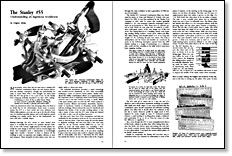
Synopsis: Because of its apparent complexity, the Stanley No. 55 Universal Combination plane is often relegated to the collector’s shelf, writes Gregory Schipa, who says it’s actually an addictive tool. With a little patience, you can set it up to do the job of any one of a hundred specialty planes; it will duplicate period moldings you simply cannot find in the lumberyards, nor even mill with a spindle shaper. He details its history and how he came to use and love his. He describes its relationship to some of the planes it replaces and when it’s more effective just to grab a router. Then he explains how to set it up, use it in its primary functions, and where to find one. Side information by T. D. Culver talks about how to restore and use a No. 55.
Most people, when they first set eyes upon a Stanley #55 Universal Combination Plane, are sure they’ve discovered the ultimate contraption, though one undoubtedly too crazy to work. That’s what I first thought, yet many years later the #55 has grown to be a part of me. As the Stanley Tool Company modestly described it in their 1897 catalog: Combining as it does all the so-called ‘Fancy’ Planes, its scope of work is practically unlimited, making the Stanley #55 literally ‘A planing mill within itself.’ I have my reservations about that sweeping claim, but there is no doubt that for the cabinetmaker, house joiner or restorationist, the #55 is a most useful and even addictive tool. With a little patience, you can set it up to do the job of any one of a hundred specialty planes, and it will duplicate period moldings you simply cannot find in the lumberyards, nor even mill with a spindle shaper.
History—Although the #55 seems to have landed from space, it is actually the product of a gradual, rational evolution. In the 19th century, single-purpose wooden planes, basically the same design as had been used in ancient Egypt and Rome, had multiplied until a cabinetmaker or housewright might have needed a hundred of them to fashion all the moldings in style, an expensive and weighty collection to store and transport. These beautiful wooden planes were also unstable, liable to check and warp.
The Industrial Revolution provided a metal technology that avoided wood’s drawbacks. In 1871, after successfully marketing a series of cast-iron bench planes, Stanley introduced the “Miller Combination Plane” as a replacement for the carpenters’ plow—it employed metal screw threads instead of wood, and a sole that “would not warp or swell.” Within a few years Stanley came out with the #45, which replaced a boxful of plows, fillisters and beaders. Meanwhile, improvements in machinery resulted in abundant, newly available mill-run moldings, which reduced the need for handwork and hastened the decline of the wooden molding planes. It was only a matter of time until the #55 came along and claimed to be able to take over all molding functions.
My crew and I have four of the contraptions, and they are invaluable for the restoration work we do. It’s curious how we came to discover them. I had been using old wooden planes to duplicate moldings, and had even had a few new ones made for me by Norman Vandal (FWW #37, p. 72). I’d picked up some old metal planes, too, including a Stanley #45 with interchangeable cutters. I remember musing to myself that the #45 would be able to do just about anything if only it had sole runners that could be adjusted vertically as well as horizontally.
From Fine Woodworking #38
For the full article, download the PDF below:
Fine Woodworking Recommended Products

Stanley Powerlock 16-ft. tape measure

Starrett 12-in. combination square

Marking knife: Hock Double-Bevel Violin Knife, 3/4 in.





















Log in or create an account to post a comment.
Sign up Log in